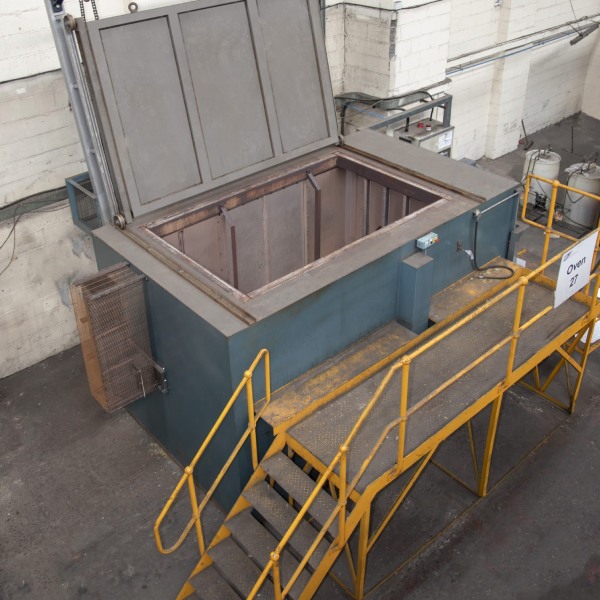PRECIPITATION HARDENING
Our Age Hardening Process:
In the quenched state (SSSS), since the degree of solid solubility of alloy solute within the solid alloy solution decreases with decrease in temperature, precipitation zones of solid alloy solute occurs, over a period of time, at room temperature. As precipitation zones increases, stresses of metallurgical bonds between each precipitate zone and the solid solution, resulting in a progressive increase in alloy strength, hence the terms ageing / age hardening. At peak strength precipitation zones have grown to their critical size and are regarded as fully coherent with the solid solution.
What Is Precipitation Hardening?
Precipitation hardening, also known as age hardening or ageing, is a widely used heat treatment process that improves the strength and durability of metals and alloys. This process is performed after solution treatment and quenching, where the metal or alloy is held at an elevated temperature, typically between 100 and 200ºC, to allow for the formation of fine, uniformly distributed precipitates within the material. In this blog, we will explore the details of the precipitation hardening process, its advantages and disadvantages, and its applications in the aerospace, automotive, and engineering sectors. The process occurs after products have been solution treated and quenched (ie: when products are in W or AQ temper).

Quenching Of Alloys
Quenching is a heat treatment process that involves rapid cooling of a metal or alloy from a high temperature to a low temperature to achieve specific material properties. This process is commonly used in conjunction with precipitation hardening, as it prepares the material for the next step of the heat treatment process. Quenching is required to entrap a super saturated solid solution, which is a prerequisite, for effective age hardening.
The Precipitation Process
The precipitation process occurs very slowly at room temperature, and can take many hours, days or even weeks to achieve desired mechanical properties. Temper designations for the solution treated and naturally aged states are: TB, T3, T4 (same as T3 but less cold work), T42 (same as T4 but not “mill” produced). It is common practice to cold work wrought products after quenching, resulting in additional digits to the codes eg T351, T352, T452 etc.
Artificial Ageing and Over Aging Metals & Alloys
Age hardening time can be reduced from weeks / days to hours by soaking the alloy parts at elevated temperatures (instead of room temperature), typically between 100 and 200ºC, and is termed as artificial ageing. Generally, as ageing temperature increases, the required process time to arrive at peak strength, decreases. Temper designations for the solution treated and artificially aged states are: TF, T6, T8 (same as T6 but aged from T3), T62 (same as T6 but not “mill” produced).
However, when optimising age hardening process time, there is a critical temperature limit, which varies depending on alloy grade, where above this critical limit, peak mechanical properties start to fade, termed as over-ageing. At temperatures above the critical limit, further heat expansion of the product allows precipitation zones to grow beyond their limits of coherency. Beyond the limits of coherency, stressed metallurgical bonds between precipitates zones and solid solution break and reform. Breaking and reforming of metallurgical bonds releases alloy stress, resulting in a decline of strength, with increase in over-ageing time.
Certain alloys, 7xxx series grades in particular, require over-ageing to increase corrosion resistance at the expense of strength, where the degree of over-ageing is monitored by hardness and electrical conductivity testing. Temper designations for the solution treated and over-aged states are: TB7, TF7, T73, T74, T76.
Annealing is effectively caused by gross over-ageing, where in the annealed state (O), precipitation is regarded as fully incoherent, resulting in lowest strength and highest ductility.
Pros & Cons of Age Hardening
Precipitation hardening provides a number of advantages for metals and alloys. The process increases the strength and hardness of the material, while also improving its resistance to wear and corrosion. This makes precipitation-hardened alloys ideal for use in high-stress applications where strength and durability are critical.
There are two main disadvantages:
- Cost of the process, as it requires additional steps beyond solution treatment and quenching. Some precipitation hardening process durations can be over many days, which may be more expensive than other heat treatment processes, such as annealing or normalizing.
- Rapid cooling during quenching can cause excessive material distortion and sometimes cracking, particularly at poor quality weld points, or poor quality castings.
Applications of Age Hardening
The aerospace, automotive, and engineering sectors all rely heavily on the use of quenched and precipitation-hardened alloys. These industries require materials that are strong, durable, and resistant to wear and corrosion, making precipitation-hardened alloys an ideal choice.
In the aerospace industry, precipitation-hardened alloys are used extensively in the production of aircraft parts and components, including landing gear, wing spars, and engine components. These alloys provide exceptional strength and durability, making them well-suited for the harsh conditions of flight.
In the automotive industry, precipitation-hardened alloys are used in a variety of applications, including engine parts, suspension components, and drivetrain components. These alloys provide the necessary strength and durability to withstand the stresses of high-performance driving.
In the engineering sector, precipitation-hardened alloys are used in a wide range of applications, including structural components, fasteners, and gears. These alloys provide exceptional strength and durability, making them well-suited for the demanding conditions of engineering applications.
Age Hardening: Temper Designations & Alloy Series Numbers
Temper designations are used to indicate the state of an alloy after precipitation hardening. These designations include the letter T followed by a number that indicates the aging temperature and time.
For example, after solution treatment and quenching a material that has been aged at 175°C for 8 hours would be designated as T6. The aging temperature and time can vary depending on the alloy and the desired properties.
Aluminium alloys with the combinations of copper, silicone, zinc & magnesium are the typical precipitation hardening alloys.
There are many grades of alloys that can be subjected to the precipitation hardening process, each with its own unique characteristics and properties.
Aluminium alloys are particularly popular for use in precipitation hardening, as they are lightweight, corrosion-resistant, and have high strength-to-weight ratios. Some of the most common aluminium alloys used for precipitation hardening include Aluminium alloy series numbers: 2024, 6061, and 7075.
What do these alloy series numbers mean? Each number denotes how much of each composite material is in each aluminium alloy, to denote to the manufacturers and engineers what each part is made up of.
Some examples of Aluminium Alloy Series Numbers:
2024 = aluminium alloy with copper & magnesium
6061 = aluminium alloy with magnesium & silicon.
7075 = aluminium alloy with copper, magnesium & zinc.
Precipitation Hardening FAQ’s
Precipitation hardening or age hardening offers several advantages, including improved strength, hardness, and wear resistance in metals and alloys. It allows for enhanced design flexibility and the ability to achieve desired material properties through controlled heat treatment processes.
Metals and alloys commonly subjected to precipitation hardening include aluminium alloys (e.g., 2024, 7075), stainless steels (e.g., 17-4 PH, 15-5 PH), nickel-based alloys (e.g., Inconel 718), and some copper alloys (e.g., beryllium copper).
The typical process for precipitation hardening involves solution heat treatment, quenching, and aging. Solution heat treatment is performed to dissolve the alloying elements uniformly, followed by rapid quenching to retain them in a supersaturated solid solution. Aging is then carried out at a specific temperature to promote the formation of fine precipitates and the desired strengthening mechanism.
During aging, the formation of fine precipitates occurs, which act as barriers to dislocation movement and strengthen the material. The size, distribution, and type of precipitates influence the material’s mechanical properties, such as strength, hardness, and toughness.
No, not all metals and alloys can undergo precipitation hardening. It depends on the alloy’s composition and the ability of certain elements to form stable precipitates during the aging process.
Yes, different methods of aging can be used in precipitation hardening, such as natural aging, artificial aging, or multiple-step aging. These methods vary in terms of temperature, time, and cooling rates, allowing for the optimization of material properties based on specific requirements.
Several factors influence the effectiveness of precipitation hardening, including the alloy composition, solution heat treatment temperature and time, quenching rate, aging temperature and time, and cooling rates during the process. These parameters need to be carefully controlled to achieve the desired material properties.
In some cases, the aging process can be accelerated using higher temperatures or multiple-step aging techniques. However, it is crucial to balance the need for shorter production time with the desired material properties and potential risks, such as over-aging or excessive grain growth.
Precipitation hardening may pose challenges such as distortion or dimensional changes during heat treatment, the need for precise control of process parameters, and the possibility of undesirable phase transformations or over-aging if not performed correctly. Proper process control and understanding of the material’s behaviour are essential to overcome these challenges.
Yes, a metallurgy firm or heat treatment company with expertise in precipitation hardening can provide valuable assistance in optimising the process parameters, material selection, and heat treatment cycles to achieve the desired material properties efficiently and effectively.







